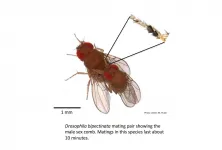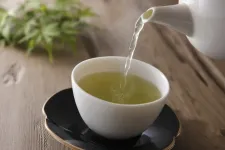(Press-News.org) Scientists have accepted natural selection as a driver of evolution for more than 160 years, thanks to Charles Darwin.
But University of Cincinnati biologist Michal Polak says Darwin's book "The Descent of Man" only tells part of the story. Sometimes when the victor vanquishes his sexual rival, the quest to pass genes to the next generation is just beginning.
According to a new UC study published in the journal Current Biology, male fruit flies with the most impressive sexual ornamentation also have super sperm that can outcompete that of rivals in the post-mating fertilization game.
UC studied Drosophila bipectinata, a tiny red-eyed fruit fly from the South Pacific. The male's forelegs have a distinctive "sex comb," dark bristles that female fruit flies find appealing -- like the colorful train of a male peacock. Scientists previously found that female flies prefer males with more robust sex combs, which the males use to grasp the female's abdomen before mating.
UC researchers found a strong link between the most impressive sex combs and that male's competitive success at passing on his genes even after a female fly has mated with other flies. And this competitive edge persisted even after the male's sex comb was surgically removed with a high-precision laser in UC experiments.
"This is the first robust demonstration of a genetic link between a traditionally Darwinian trait and success in postcopulatory sexual competition," Polak said. "That's the surprising link: precopulatory and postcopulatory fitness."
In his groundbreaking 1859 book "On the Origin of Species," Darwin framed the idea of natural selection by describing how the "fittest" animals pass on their genes to the next generation. This fitness is manifested in having the largest antlers, the most vibrant colors or the vigor to defend a territory.
But Darwin's theory was incomplete, Polak said, because it failed to recognize that sexual selection continues during and after mating. Female fruit flies are promiscuous, often choosing multiple mates. Fruit flies are hardly alone in that regard, Polak said.
"Promiscuity is much more common across animal species than once was thought," Polak said.
Scientists living in prim and proper Victorian England did not give enough consideration to the microscopic race to fertilize that begins after mating among multiple successful suitors.
"You have to consider the social context in which Darwin was living," Polak said.
What females gain from mating with multiple suitors is not always clear, Polak said. But when they do, postcopulatory sexual selection provides a competitive edge.
"It's evident even in primates. Female chimpanzees and bonobos are promiscuous, so the males have large testes that produce big volumes of sperm," Polak said.
"And you have species like gorillas where females are not promiscuous. Silverback males enforce monogamy. And lo and be hold, their testes are much smaller relative to body size compared to chimps."
And if you're wondering, the relative size of human testes falls somewhere between gorillas and chimps, Polak said.
Polak, a professor of biology in UC's College of Arts and Sciences, decided to study this species of fruit fly after encountering it while conducting fieldwork in Queensland, Australia.
"I was watching these flies mate on a fruit and looked under the microscope and saw these beautiful sex combs. I thought it would make a good model system to study," Polak said.
"Sexual selection picks up on these traits and they become really exaggerated," he said.
For their study, UC biologists artificially selected males with the largest and smallest sex combs in 11 successive generations of fruit flies to create high and low genetic lines.
Kassie Hooker from 2012 to 2015 worked in Polak's lab as an undergraduate biology student, undertaking the arduous task of categorizing generations of male fruit flies based on the size of the sex combs on their legs. By counting the teeth in each comb, she separated the males with the largest and smallest sex combs to create distinct genetic lines.
To show that the male fruit fly's sex comb doesn't provide any reproductive benefit in mating, researchers used ultraprecise lasers to trim the sex comb in the high line males to mimic those found in the low line males. But these postsurgical males continued to fertilize more eggs even when females mated with lower-line males first.
The research was supported by the National Science Foundation.
UC assistant professor Joshua Benoit, a study co-author, analyzed the RNA of the flies and identified seminal fluid genes that may be responsible for giving high-line males a fertilization advantage.
"There aren't many studies more interesting than this one," Benoit said. "Sex, lasers, and male competition, which could describe most 1980s action movies."
Darwin proposed the theory of sexual selection to account for the evolution of male weaponry and extravagant ornamental displays, Polak said. But UC's study found a far more complex and interesting battle among the sexes.
"We established a link between Darwinian traits and the postcopulatory arena, which Darwin didn't recognize was important in evolution at all," Polak said.
INFORMATION:
Researchers of the Research Programme on Biomedical Informatics (GRIB) from UPF and Hospital del Mar Medical Research Institute (IMIM) in Barcelona, Spain, have identified behavioural and linguistic changes in tweets in Spanish published by users suffering from depression and who are taking medication to treat this disease.
Their work has been published in Journal of Medical Internet Research and was led by Ferran Sanz; with Angela Leis and Francesco Ronzano as first authors, who conducted the work together with Miguel Angel Mayer and Laura I Furlong, all from the Integrative Biomedical Informatics research ...
Fast and energy-efficient future data processing technologies are on the horizon after an international team of scientists successfully manipulated magnets at the atomic level.
Physicist Dr Rostislav Mikhaylovskiy from Lancaster University said: "With stalling efficiency trends of current technology, new scientific approaches are especially valuable. Our discovery of the atomically-driven ultrafast control of magnetism opens broad avenues for fast and energy-efficient future data processing technologies essential to keep up with our data hunger."
Magnetic materials are heavily used in modern life with applications ranging from fridge magnets to Google and Amazon's ...
Birdwatchers get very excited when a 'rare' migratory bird makes landfall having been blown off-course and flown beyond its normal range. But these are rare for a reason; most birds that have made the journey before are able to correct for large displacements and find their final destination.
Now, new research by an international team shows for the first time, how birds displaced in this way are able to navigate back to their migratory route and gives us an insight into how they accomplish this feat.
Writing in Current Biology, the team from Bangor and Keele Universities describe how reed warblers can navigate from a 'magnetic position' beyond what they have ...
What The Study Did: These findings suggest that treatment with zinc, ascorbic acid or both doesn't affect SARS-CoV-2 symptoms.
Authors: Milind Y. Desai, M.D., M.B.A., of the Cleveland Clinic in Ohio, is the corresponding author.
To access the embargoed study: Visit our For The Media website at this link https://media.jamanetwork.com/
(doi:10.1001/jamanetworkopen.2021.0369)
Editor's Note: The article includes conflict of interest disclosures. Please see the article for additional information, including other authors, author contributions and affiliations, conflict of interest and financial disclosures, and funding and support.
INFORMATION:
Media advisory: The full study is linked to ...
What The Study Did: Pediatric admissions to U.S. hospitals decreased last year across an array of pediatric conditions and some may represent unmet needs in pediatric care during the COVID-19 pandemic.
Authors: Christopher M. Horvat, M.D., M.H.A., of UPMC Children's Hospital of Pittsburgh, is the corresponding author.
To access the embargoed study: Visit our For The Media website at this link https://media.jamanetwork.com/
(doi:10.1001/jamanetworkopen.2020.37227)
Editor's Note: The article includes conflict of interest and funding/support disclosures. Please see the article for additional information, including other authors, author contributions and affiliations, conflict of interest and financial disclosures, and funding and support.
INFORMATION:
Media advisory: ...
What The Study Did: This observational study investigated the sensitivity of antibody tests to detect previous SARS-CoV-2 infection using existing clinical data across the University of California Health system.
Authors: Atul J. Butte, M.D. Ph.D., of the University of California, San Francisco, is the corresponding author.
To access the embargoed study: Visit our For The Media website at this link https://media.jamanetwork.com/
(doi:10.1001/jamanetworkopen.2021.0337)
Editor's Note: The article includes conflict of interest and funding/support disclosures. Please ...
TROY, N.Y. -- An antioxidant found in green tea may increase levels of p53, a natural anti-cancer protein, known as the "guardian of the genome" for its ability to repair DNA damage or destroy cancerous cells. Published today in END ...
What The Study Did: This case series analyzes brains from autopsies of patients who died of COVID-19 as confirmed by nucleic acid test and with severe pulmonary pathology.
Authors: David W. Nauen, M.D., Ph.D., of Johns Hopkins University in Baltimore, is the corresponding author.
To access the embargoed study: Visit our For The Media website at this link https://media.jamanetwork.com/
(doi:10.1001/jamaneurol.2020.0225)
Editor's Note: The article includes conflicts of interest disclosures. Please see the article for additional information, including other authors, author contributions and affiliations, ...
PHILADELPHIA--The "scarred villain" is one of the oldest tropes in film and literature, from Scar in "The Lion King" to Star Wars' Darth Vader and the Joker in "The Dark Knight." The trope is likely rooted in a long-evolved human bias against facial anomalies -- atypical features such as growths, swelling, facial paralysis, and scars. A new brain-and-behavior study from researchers in the Perelman School of Medicine at the University of Pennsylvania illuminates this bias on multiple levels.
The researchers, whose findings were published this week in the Annals of the New York Academy of Sciences, used surveys, social simulations, and functional MRI (fMRI) studies to study hundreds of participants' responses and attitudes towards ...
Since ancient times, St. John's Wort has been used as a medicinal herb covering a wide range of applications such as the treatment of burns, skin injuries, neuralgia, fibrosis, sciatica and depression. Due to its high medicinal potential, the plant known in technical terminology as Hypericum perforatum even became "Medicinal Plant of the Year" in 2015. Now, scientists at TU Dresden have shown that there is much more to the herb than its healing properties.
To this end, two interdisciplinary groups from biology and inorganic chemistry have joined forces and thus achieved astonishing results.
Originally, the research groups led by botanist Prof. Stefan Wanke ...





